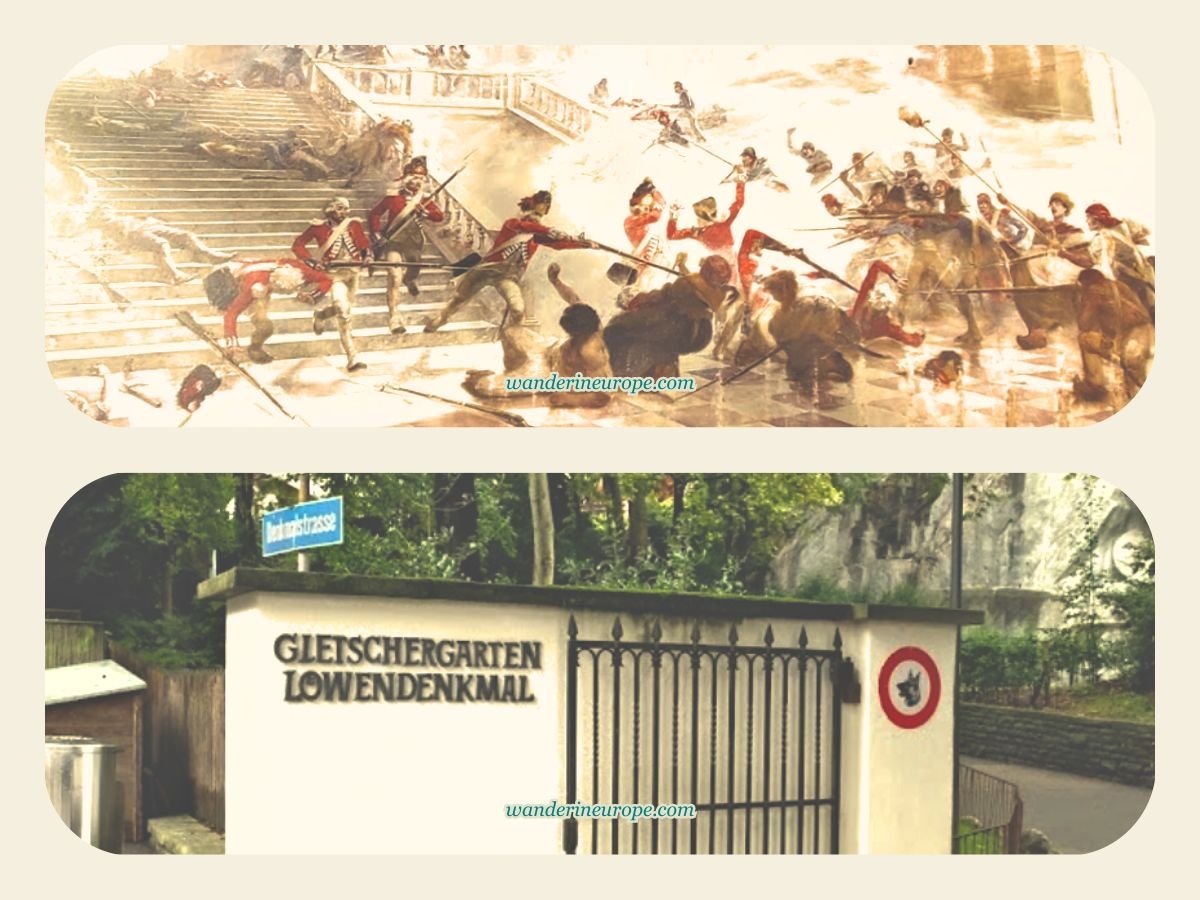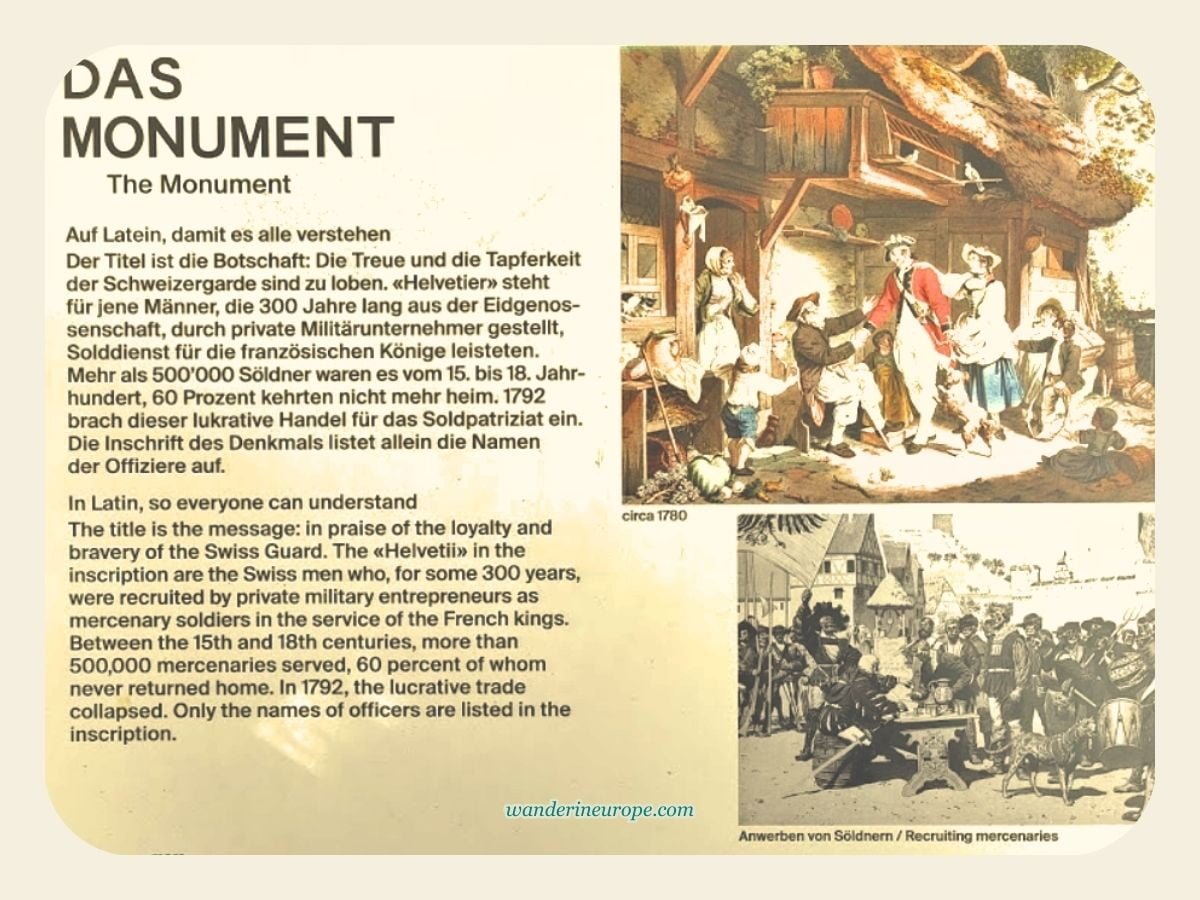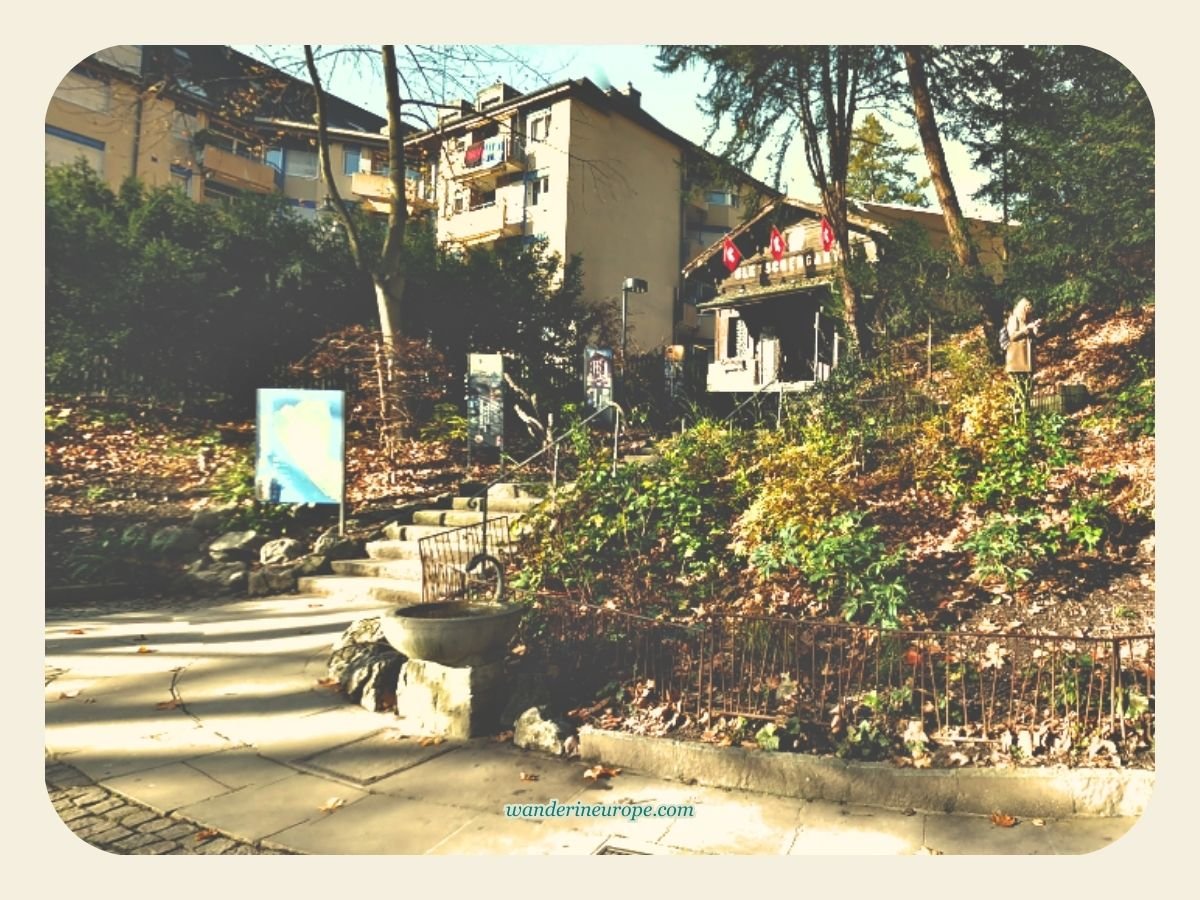Things to Know Before Visiting the Lion Monument in Lucerne
WanderInEurope is reader-supported. Affiliate links and ads help us keep creating useful content for you.
After exploring Lucerne, I discovered many interesting places that I believe every wanderer would enjoy. Some of them are free to visit, while others offer unique experiences. I also found things that make Lucerne a beautiful city. Out of everything I’ve come across, there’s one standout that fits all three categories: The Dying Lion Monument of Lucerne.
It’s a must-see, whether you’re planning a 3-day stay, a 2-day trip, or even a 1-day visit to Lucerne. The Dying Lion Monument is unique, free to visit, and beautiful. Not to mention, it’s a very meaningful monument. I’m not a fan of Mark Twain, but it was he who said that the Lion Monument of Lucerne is “the most mournful and moving piece of stone in the world.” I couldn’t disagree when I first saw it, and even more so when I learned the story behind the monument.
Fun fact! The Dying Lion of Lucerne is a gigantic (6 meters tall) and famous landmark, replicated several times in different parts of the world, much like the Statue of Liberty. Don’t wonder why it’s so famous: The emotion in the face of the lion spills to anyone who sees it!
Let me share all the interesting things I learned about the Lion Monument. And if you want to visit the Dying Lion Monument in Lucerne, I’ve got all the information you need!

The Meaning
Every monument we construct serves to commemorate something, be it notable individuals or significant events. The Dying Lion Monument in Lucerne is no exception, commemorating both. As the name of the monument suggests, it doesn’t commemorate a joyous event, but a tragic one. It honors the Swiss Guards who lost their lives during the French Revolution on August 10, 1792, while defending the last French Monarch.
The Latin inscriptions on the monument serve as a testament to the loyalty and bravery of the Swiss Guards. When you visit, you’ll notice the Roman numerals also inscribed on the monument: “DCCLX” (760) and “CCCL” (350). These represent the number of Swiss Guards who were killed and survived the event, respectively.
The Dying Lion Monument was commissioned by Karl Pfyffer von Altishofen, a Swiss Guard who was on leave during the incident in August 1792. He also authored a book about the Swiss Guards, which garnered public sympathy and funding for the monument.



Visiting Expectations
Given the monument’s popularity, it’s not unbelievable what the local tourism board of Lucerne tells its visitors: The Dying Lion Monument receives millions of visitors each year.
The group tours, packed with dozens of tourists exploring the city, will convince you that the Dying Lion Monument indeed is visited by countless people throughout the year. Almost every one of these group tours have the Lion Monument as one of their stops. Especially during the peak season, you can really expect many people visiting the monument.
On a lighter note, most of these tourists only come and go. Based on the tour itineraries I found, only 15-20 minutes are allocated to the Dying Lion Monument. After their tour guides finish giving insights about the Lion Monument and after taking photos of the monument, they leave and proceed to the next stop in the city.
So, no, the Lion Monument doesn’t become a sea of people.


Actually, the Dying Lion Monument is more than just a monument; it’s a small park. The sculpture of the lion, carved into the rock wall, lies above the park’s pond. You’ll see it immediately upon entering the park. If I were to describe the park, it’s divided into two parts. The first is where you can find the lion sculpture, and the second part is the elevated portion, which is typically quiet and not frequented by tourists. Both parts of the park have benches where you can sit and relax.
If you’re planning to spend more time here, I’d recommend staying in the elevated part of the park. It’s more shaded, quiet, and offers an overlooking view of the sculpture. It’s a great spot for a quick break and to eat some snacks as you explore the city, say, if you’re on your own walking tour of Lucerne.
And here’s a tip: there’s a free-to-use toilet in the park. You should spot it right away to the right while you’re looking at the sculpture of the Dying Lion.
Things to Do
Taking the time to appreciate the monument is an absolute must when visiting the Dying Lion Monument. It’s the heart and soul of the experience! But if you’re curious about what else there is to do, here are a few more things you might enjoy:
First, learn the history of Lucerne’s Dying Lion Monument. Sure, anyone can research the monument before visiting. But for a slightly enhanced experience, I suggest learning about the monument on-site. There’s something unique about standing beside the pond, in front of the Dying Lion Monument, as you unravel its history.
The tourism office has placed interpretive panels near the entrance where you can find details about the Dying Lion Monument. They’ve included QR codes, which, when scanned with your mobile phone, will provide information about the monument in various languages. Last time I checked, I noticed panels beside the pond. They contained explanations of the different symbols depicted by the monument. You’ll also see images of historical events related to the recruitment of mercenaries for the service of the French king.




Secondly, take a moment to reflect on the message that the Dying Lion Monument conveys. Contemplating the bravery and loyalty of the Swiss soldiers can be a part of your self-improvement journey. Ask yourself, what can I do to be a hero in my own country, community, or family?
Third, don’t forget to take photos! Even though the Dying Lion Monument might seem simple, there are plenty of great photo opportunities in the park where it’s located. One such opportunity is the pond, which beautifully reflects the lion sculpture on its surface. This can make for some awesome photos of the monument.
Fourth, try visiting the Glacier Garden. You can head over to the Glacier Garden right after seeing the monument. Its entrance is also located in the park where the Lion Monument stands. In a nutshell, the Glacier Garden is a museum where you can find glacial potholes, fossils, and exhibits about Lucerne and glaciers. The most interesting things I found inside were the 9.5-meter deep pothole and a diorama of Lucerne from the year 1792.
You can learn more about the Glacier Garden on their official website, which is linked at the end of this post. You can find the most affordable experiences in Lucerne here.



How to Get There
Are you planning a visit to the Lion Monument, or are you on your way there now?
If you’re wondering where it is, the Dying Lion Monument is located along Denkmalstrasse, just outside the old city of Lucerne. It’s also situated northeast of the medieval city center, near other museums and art galleries like the Diorama of the Alps, Bourbaki Panorama Lucerne, and Spiegelmuseum.
Here is a map of Old Town Lucerne to see the exact location of the monument.
Reaching the Dying Lion Monument is a piece of cake! It’s conveniently accessible whether you choose to use public transportation or walk, especially if you’re already in Lucerne’s old city. From any location in the Old City of Lucerne, it’s less than a 20-minute walk to the Lion Monument.
Let’s say you’re visiting from other must-see landmarks in Lucerne… from the Church of Saint Leodegar, the monument is just a 7-minute walk away. From the Zytturm of Musegg Wall, it’s only a 10-minute walk to the Dying Lion Monument. It’s also a 10-minute walk from the Chapel Bridge. If you’re coming from the Jesuit Church or the train station, it’s about a 15-minute walk to the Lion Monument.
If you’d rather not walk to the Lion Monument, you can take the bus (#1, #19, N1). These buses have stops at Wesemlinrain and Löwenplatz, both of which are very close to the monument. From these bus stops, it’s only a 1 to 2-minute walk to the Lion Monument.
Best Time to Visit
The Lion Monument is open 24 hours a day, so you can visit at your convenience. However, for a more enriching experience, I recommend visiting during off-peak hours. It’s best to visit when it’s peaceful and quiet, allowing you to reflect on the history and values the monument represents.
If you’re planning a trip to Switzerland or Lucerne in the fall, be sure to include the Lion Monument in your itinerary. The park where the monument is located becomes magical with the colors of fall foliage! You’ll absolutely enjoy taking photos of the monument during this season.
More in Lucerne
Thinking about visiting Lucerne? WanderInEurope has put together guides, itineraries, and travel tips to help you plan an amazing trip. Click the button below to check them out!
From great hotel deals to skip-the-line tickets and affordable eSim to cheap rentals, click here for the best hotel deals and more travel discounts.
For a convenient, unique, or more enriching visit, check out these experiences and services:

Learn More
You can learn more about the Lion Monument of Lucerne from the websites where I sourced the facts and information for this post. I’ve also added links that will be helpful for your visit to the monument.
For a more insightful visit to Old Town Lucerne, including the Dying Lion Monument, it’s usually suggested to join a guided tour with a knowledgeable local. The guide will not only share facts and interesting history but also give you tips on the best restaurants and what’s new in the city.

Pin this to save it for later or bookmark it to read anytime.











